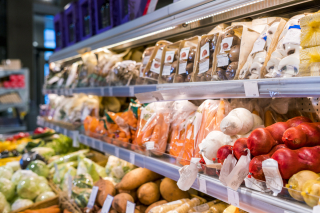
Chemicals used to replace bisphenol A (BPA) in food packaging can trigger potentially harmful effects in human ovarian cells, according to researchers at McGill University. A recent study highlights early signs of potential toxicity from several chemicals commonly used in price stickers on packaged meat, fish, cheese, and produce, raising significant concerns about the safety of BPA-free packaging.
The findings, published in the journal Toxicological Sciences, question whether current regulations are sufficient to protect consumers. The study reveals that BPA substitutes may disrupt gene expression, posing risks that have yet to be fully understood.
BPA Substitutes and Gene Disruption
The research was initiated by Stéphane Bayen, Associate Professor in McGill’s Department of Food Science and Agricultural Chemistry, who discovered in 2023 that label-printing chemicals like bisphenol S (BPS), a BPA replacement, were leaching through plastic wrap into food. Collaborating with reproductive toxicology experts, Bayen aimed to investigate the potential internal effects of these substances.
In the study, lab-grown human ovarian cells were exposed to four commonly used BPA substitutes: TGSA, D-8, PF-201, and BPS. The results showed that several of these chemicals, particularly TGSA and D-8, caused a buildup of fat droplets in the cells and altered the activity of genes responsible for cell growth and DNA repair.
“These are major cellular functions,” said Bernard Robaire, co-senior author of the study and James McGill Professor in McGill’s Departments of Pharmacology & Therapeutics and Obstetrics & Gynecology. “Disrupting them doesn’t prove harm in humans, but it gives us a strong signal that these chemicals should be further investigated.”
Unregulated Replacements Under Scrutiny
BPA has long been a concern due to its ability to interfere with the body’s hormones, linking it to fertility issues, early development problems, and metabolic disorders. As a result, it has been banned in baby bottles and restricted in certain products in Canada. However, many chemicals used to replace BPA are not regulated or routinely tested, according to the researchers.
“‘BPA-free’ is an incredibly misleading label,” Robaire noted. “It usually means one bisphenol has been swapped for another, and there are more than 200 of them. Some may be just as harmful, or even worse. We need to test these compounds before they’re widely adopted, not after.”
Health Canada has responded by adding all four substances studied to a list of chemicals requiring further investigation. This move represents a critical step in addressing the potential health risks posed by these unregulated replacements.
Consumer Guidance and Precautions
For consumers seeking to minimize exposure to these chemicals, Robaire suggests practical measures such as removing labels and plastic wrap from fresh foods before storage. Additionally, he advises choosing items from the top of store display piles rather than the bottom, where pressure from stacking may push chemicals more deeply into packaging and food.
About the Study
The study titled “High-content imaging and transcriptomic analyses of the effects of bisphenol S and alternative color developers on KGN granulosa cells” was authored by Lama Iskandarani, Stéphane Bayen, Barbara Hales, and Bernard Robaire. It was published in Toxicological Sciences and supported by the McGill Sustainability Systems Initiative.
The announcement comes as consumers and regulators alike are increasingly vigilant about the safety of food packaging materials. As research continues, the implications of these findings could lead to more stringent testing and regulation of BPA substitutes, ensuring better protection for public health.







